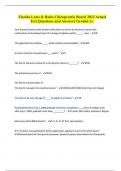OAE MUSIC EXAM 2024|ACTUAL EXAM QUESTIONS WITH
DETAILED ANSWERS|LATEST UPDATE|EXPERT VERIFIED
FOR GUARANTEED PASS
Allemande - CORRECT ANSWER - A musical composition or movement (as in a baroque suite)
in moderate tempo and duple or quadruple time.
Fugue - CORRECT ANSWER - A polyphonic genre featuring the alternation of the tonic subject
with non-tonic thematic entries.
Marcato - CORRECT ANSWER - A musical instruction indicating a note, chord, or passage is to
be played louder or more forcefully than the surrounding music.
Pizzicato - CORRECT ANSWER - Technique of plucking strings rather than using a bow.
Half Diminished Chord - CORRECT ANSWER - Consists of a diminished triad with a minor
seventh above the root.
Whole Tone Scale - CORRECT ANSWER - A scale consisting entirely of intervals of a tone,
with no semitones.
Octatonic Scale - CORRECT ANSWER - A scale that most often refers to the symmetric scale
composed of alternating whole and half steps.
Pentatonic Scale - CORRECT ANSWER - A scale which removes the 4th and the 7th from the
major scale.
Blues Scale - CORRECT ANSWER - A musical scale consisting of 1, flat3, 4, sharp4, 5, and a
flat7.
Arpeggiation - CORRECT ANSWER - Refers to the sounding of notes of a chord one after
another melodically rather than simultaneously.
,Conjuct Motion - CORRECT ANSWER - The interval between two consecutive scale degrees.
Any larger interval is called a skip (also called a leap), or disjunct motion.
Parallel Period - CORRECT ANSWER - Indicates that the second phrase is a repetition of the
first phrase.
Asymmetrical Period - CORRECT ANSWER - There is an uneven number of antecedents and
conseequents.
Contrasting Period - CORRECT ANSWER - Form where the two phrases are completely
different.
Retrograde Motion - CORRECT ANSWER - A musical term that literally means "backwards and
upside down": "The inverse of the series is sounded in reverse order."
Sonata-Allegro Form - CORRECT ANSWER - The primary structural form used in the first
movement of symphonies, string quartets, and sonatas.
Theme and Variations - CORRECT ANSWER - A very common musical structure you will come
across, especially in classical music. The structure is built upon a musical idea called the theme
which is played at the start of the piece, then altered a little by each following theme.
Passacaglia and Fugue - CORRECT ANSWER - It is usually of a serious character and is often,
but not always, based on a bass-ostinato and written in triple metre. combined with a fugue. Used
quite often during the Baroque period.
Sonata-Rondo Form - CORRECT ANSWER - A musical form often used during the Classical
music era. As the name implies, it is a blend of sonata form and rondo form.
Rondo Form - CORRECT ANSWER - Involves the repeated use of a theme, set in the tonic key,
with episodes, each involving a new theme, intervening among the repetitions.
,Sonata Form - CORRECT ANSWER - A type of composition in three sections (exposition,
development, and recapitulation) in which two themes or subjects are explored according to set
key relationships. It forms the basis for much classical music, including the sonata, symphony,
and concerto.
Pedal Point - CORRECT ANSWER - A sustained tone, typically in the bass, during which at
least one foreign, i.e., dissonant harmony is sounded in the other parts.
Block Chords - CORRECT ANSWER - A chord or voicing built directly below the melody
either on the strong beats or to create a four-part harmonized melody line in locked-hands
rhythmic unison with the melody, as opposed to broken chords.
Alberti Bass - CORRECT ANSWER - A kind of broken chord or arpeggiated accompaniment,
where the notes of the chord are presented in the order lowest, highest, middle, highest.
Cadenza - CORRECT ANSWER - A virtuoso solo passage during the Classical Era inserted into
a movement in a concerto or other work, typically near the end.
Through-Composed Form - CORRECT ANSWER - A musical form that includes no return to
the previous motivic material.
Strophic Form - CORRECT ANSWER - the term applied to songs in which all verses or stanzas
of the text are sung to the same music.
Order of the Mass - CORRECT ANSWER - Contains five main fixed texts called the Ordinary:
- Kyrie
- Gloria
- Credo
- Sanctus
- Agnus Dei
, Which of the following characteristics is shared by church music of the Middle Ages and
Renaissance? - CORRECT ANSWER - A cappella Performance Practices.
Both Medieval and Renaissance church pieces were typically performed without instrumental
accompaniment.
Concerto Grosso - CORRECT ANSWER - A musical composition for a group of solo
instruments accompanied by an orchestra. The term is used mainly of baroque works.
Prelude and Fugue - CORRECT ANSWER - Form inspired by JS Bach's Well-Tempered Clavier.
Trio Sonata Form - CORRECT ANSWER - A baroque composition written in three parts, two
upper parts and one bass, and usually performed with a keyboard continuo.
French Overature - CORRECT ANSWER - Widely used in the Baroque period, its basic formal
division is into two parts, which are usually enclosed by double bars and repeat signs.
Madrigal - CORRECT ANSWER - A part-song for several voices, especially one of the
Renaissance period, typically arranged in elaborate counterpoint and without instrumental
accompaniment.
Chanson - CORRECT ANSWER - A lyric-driven French song, usually polyphonic and secular.
Motet - CORRECT ANSWER - A short piece of sacred choral music, typically polyphonic and
unaccompanied.
Cantata - CORRECT ANSWER - A medium-length narrative piece of music for voices with
instrumental accompaniment, typically with solos, chorus, and orchestra.
Which of the following movements are considered to be standard in a typical Baroque suite? -.
CORRECT ANSWER - Sarabande and gigue





